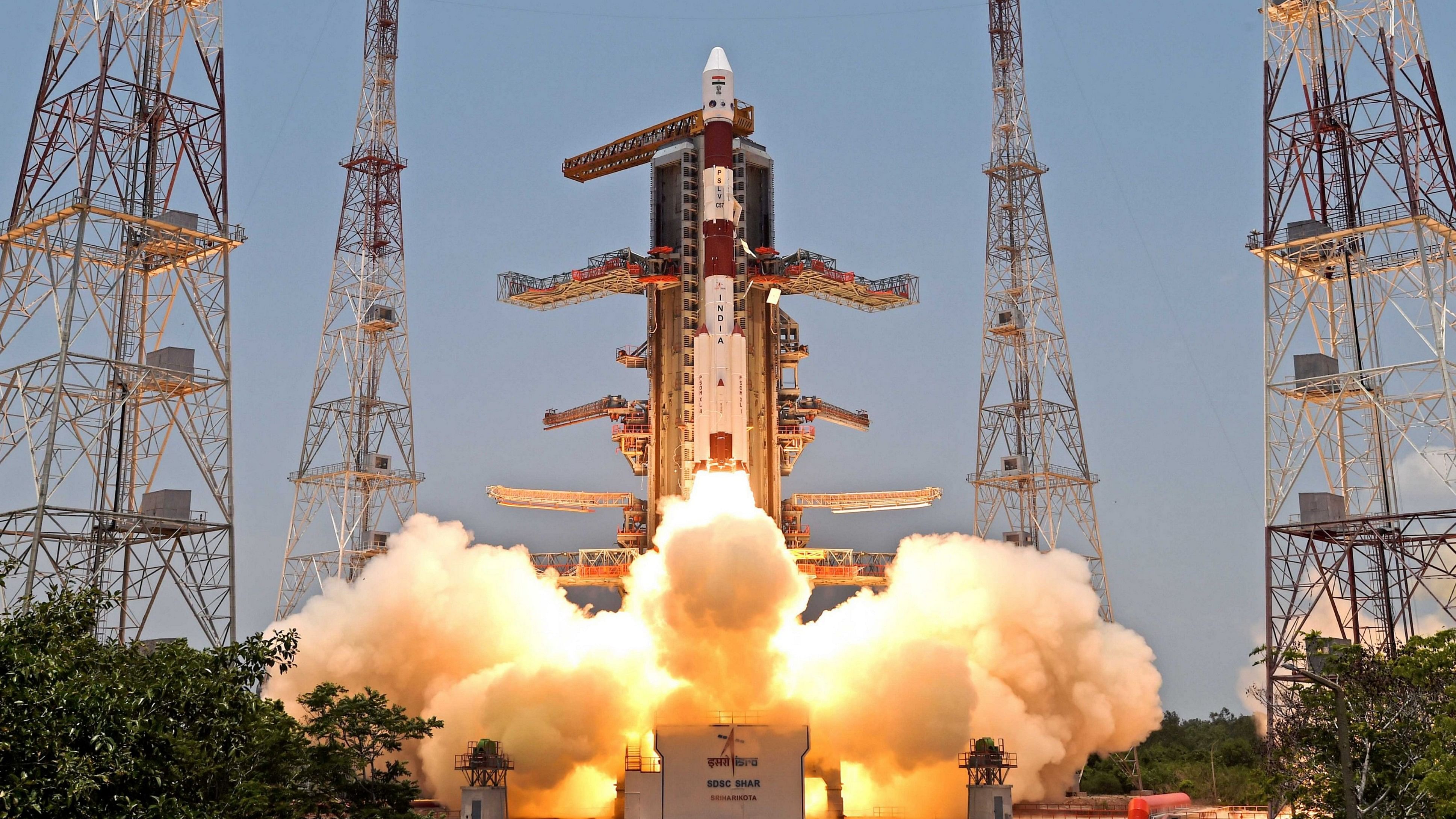
ISRO's launch vehicle PSLV-C57 rocket carrying India's first solar mission, 'Aditya-L1', lifts off from the Satish Dhawan Space Centre, in Sriharikota.
Credit: PTI File Photo
In September this year, India became the first country to land near the lunar south pole. This feat came close on the heels of India signing the Artemis Accords in June 2023 -- a US-led initiative that seeks to land the first woman and the first person of colour on the moon. This initiative will also drive lunar exploration and commercial mining of planetary resources. While the Chandrayaan-3 landing has shown India as a potential key player in an emerging lunar economy, its signing of the Artemis Accords highlighted India’s desire to be a part of the global lunar space ecosystem which is likely to shape up as the next frontier of geopolitics.
The India-US space partnership is not new. It matured in the mid-2000s. For instance, with the establishment of the US-India Civil Space Joint Working Group in June 2005 alongside the announcement of the historic nuclear deal, the partnership acquired a firm footing. This working group provided ISRO a path to collaborate with NASA on Chandrayaan-1 in 2008 as it carried the latter’s mini-synthetic aperture radar (SAR) and the moon mineralogy mapper (M3) to lunar orbit. This equipment helped Chandrayaan-1 to detect the presence of water on the moon. That mission cemented the India-US lunar partnership, laying the ground for future collaborations.
More recently, the Initiative on Critical and Emerging Technologies (iCET) signed between India and the US calls for Indian participation in human spaceflight missions and in Commercial Lunar Payload Services (CLPS) project. Other initiatives like the Innovations for Defence Excellence (IDEX) and the India-US Defence Acceleration Ecosystem (INDUS-X) has given a boost to private sector engagement in the Indian lunar space sector. However, the Artemis Accords could set a new benchmark in India-US space ties.
Introduced in 2020, the Artemis Accords are rooted in the Outer Space Treaty of 1967 and is a ‘non-binding’ multilateral arrangement for civil space exploration and peaceful uses of the Moon, Mars and other astronomical bodies. Initially, eight states became signatories to the accord -- Australia, Canada, Italy, Japan, Luxembourg, the United Arab Emirates and the United Kingdom. After much deliberation, India decided to sign on the dotted line to become the 27th member of the lunar alliance. In fact, India’s signing of the Artemis Accords on June 21 demonstrated India’s intention of engaging in ‘sustainable and transparent space activity.’ It also demonstrated India’s commitment to a multipolar world order in consonance with the Outer Space Treaty and the Moon Treaty.
India’s entry into the grouping is farsighted, given that it has struggled to be a part of different multilateral (technology denial) clubs such as the Missile Technology Control Regime (MTCR) and the Wassenaar Agreement, and still continues to be kept out of the Nuclear Suppliers’ Group (NSG) due to Chinese machinations. With the Artemis Accords, India aspires to be “inside the tent” and at the diplomatic high table when it comes to space affairs.
Such aspirations are also timely as India has announced two mega space missions: to set up an Indian Space Station by 2035 and to place the first Indian on the Moon by 2040. This is besides numerous other space missions being worked out by ISRO, such as the Venus Orbiter Mission and the Mars Lander Mission.
However, despite these positive outcomes, India will need to address principal issues to emerge as a major player in the space domain and an important ally in space for the United States.
While the success of Chandrayaan-3 has given impetus to India’s space ambitions, structural constraints continue to hamper India’s space ambitions and may potentially affect India-US space collaboration in the wake of the Artemis Accords. Concerns remain over providing an amicable regulatory environment for public-private partnerships to emerge in the space sector. India will also have to navigate the complex International Traffic in Arms Regulations (ITAR) on the US domestic side. ITAR includes a set of export control regulations that protect US security interests in different sectors, including space. The United Sates Munitions List (USML) designates 21 categories, articles and data as sensitive -- considering them “defence items”. Within the space domain, export of communication, remote sensing, navigation and multi-mission satellites as well as ground stations for telemetry, spacecrafts, launchers and propellants will come under the scanner. Getting US congressional consent will be necessary for technology transfers as well.
Addressing these steps will enable India’s further rise as a space power while giving a boost to India-US partnerships in the sector. Perhaps most importantly, the Artemis Accords complement the agreement in the Indo-Pacific where the US and India, along with other like-minded signatories, are looking to enhance transparency, promote peaceful intentions, register space objects and share scientific data to improve the safety and predictability of the space environment.
(Mishra is Fellow, ORF and Banerji is a political analyst based in Delhi and former SAV Fellow, Stimson Center.)